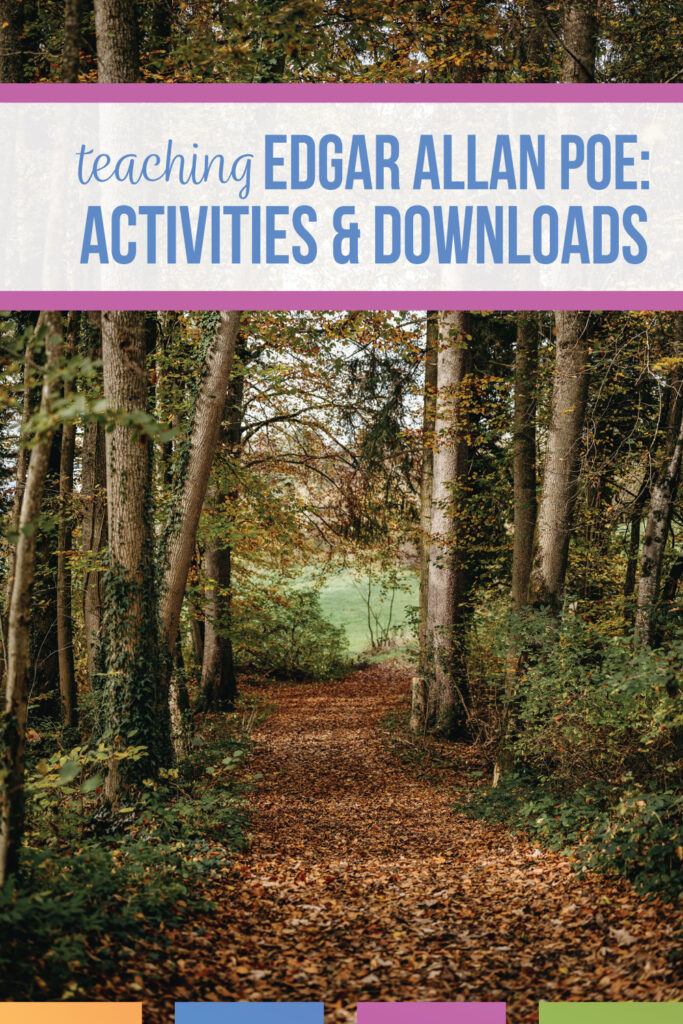Edgar Allan Poe activities should awaken students to this memorable author.
Students enjoy Poe’s stories and American gothic literature.
Teachers enjoy teaching Poe’s stories, and we can meet standards with his work.
Approaches vary: American author, dark romantic author, original author of the horror genre. Today’s students recognize his work from shows such as “Wednesday” (the fun show as a spin on “The Adam’s Family”). Other teachers use his work around spooky autumn or Halloween.
No matter your approach with Edgar Allan Poe activities, you’ll have plenty of choices. Below, find a few ways I teach Poe.
Poe Biography Movie
Since students find Poe’s life intriguing, I spend time giving them background knowledge. Once upon a time, we conducted a web search about questions with his life, but classes watched clips of the move anyway, so I developed a viewing guide to watch the documentary together.
Everyone learn about:
- Poe’s early life—his biological and adoptive parents.
- Poe as a young man.
- His wife and his relationship.
- How much (very little!) Poe was paid for some of his work.
- Famous Poe short stories.
- The controversy surrounding his death.
Different scholars present the information, and students have information to pull into analysis of his stories.
“The Masque of the Red Death”
Vocabulary is important in Poe’s tale of the plague. Since the terms are largely unfamiliar to students, I use this story to provide student choice and ownership of learning language. Standards (for upper grades) concerning language require that students learn words and use a variety of techniques to acquiring vocabulary. To this extent, I give students vocabulary bookmarks to discover what approach will help them learn words.
Additionally, similar to vocabulary, students must read a tough story! I provide guiding questions for students to answer as they read a difficult text. Some students might annotate—and annotate sufficiently!—but with this difficult text and the massive details, guided questions help. Another option is to conduct a close reading as a whole group.
“The Cask of Amontillado”
Students find this story disturbing on many levels. What is Montressor angry about? Why does this man assume he can manipulate a person who probably did nothing? What is Poe saying about human interaction? Since students find this story unusual and baffling, I find it the perfect time to work on literary analysis.
To start, I read the introduction, the first few paragraphs, aloud. The story is confusing. Why? Well, Poe write with ambiguous pronouns. So, we have an opportunity to connect language to literature. The effect of confusing pronoun use leads to suspense and a specific mood.
Any time we can connect grammar to an author’s writing style, we’ll see growth in our ELA classrooms.
Grammar with “The Raven”
“The Raven” is a haunting poem that has repetition, internal rhyme, and alliteration—perfect for teaching. Plus, students often understand and enjoy the poem, making it a win-win. Poetry activities, therefore, are a must.
When I taught younger students, I frequently taught “The Raven” in October. One fall, I realized that my teaching aligned with my teaching of verbal phrases, and I created a new activity.
In my activity, everyone look at language in context. Not only do they identify verbals (tons of verbals in this poem!), but they also consider the implications. What makes this poem memorable and effective? Do the verbals contribute?
My spin on grammar—that grammar can be taught in context—is a fun addition to a study of verbals.
“The Tell-Tale Heart”
To me, the suspense in “The Tell-Tale Heart” never becomes less-eerie. I read this story when I was (probably) way too young (before middle school) and remember my questions, my initial reactions, and my horror.
Common Lit has great activities for this story, and I utilize their writing prompts when I teach “The Tell-Tale Heart.”
Final Ideas: Edgar Allan Poe Activities
The debate between classical and modern literature bothers some ELA teachers. Pairing a few American masters (like Poe) with some recent stories makes for happy teaching.
“Click- lack the Rattle Bag” works well with “The Black Cat.” Excerpts from young adult literature are another great way to pair modern with classic stories.
Edgar Allan Poe activities are abundant, and students appreciate his odd tales. As English teachers, Poe’s work allows us to meet standards and entertain our readers.
You can check out my Edgar Allan Poe activity bundle for more ideas.
Do you need more ideas for teaching class literature? Check out my posts on Animal Farm, Julius Caesar, and Romeo and Juliet.



